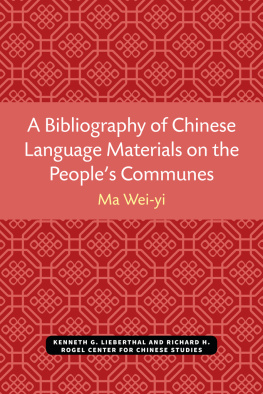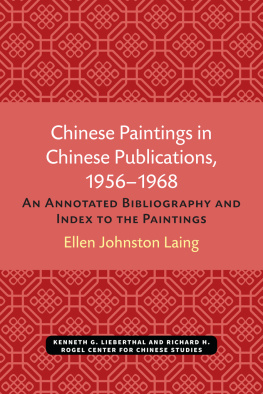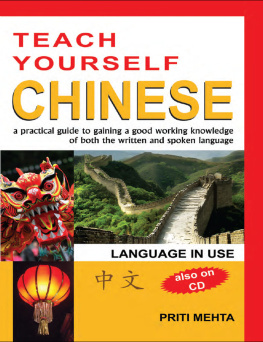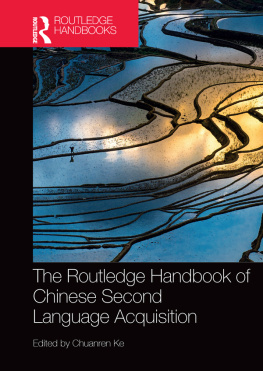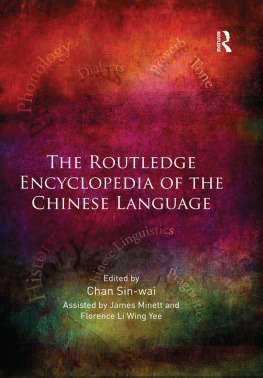Wei-yi Ma - A Bibliography of Chinese-Language Materials on the People’s Communes
Here you can read online Wei-yi Ma - A Bibliography of Chinese-Language Materials on the People’s Communes full text of the book (entire story) in english for free. Download pdf and epub, get meaning, cover and reviews about this ebook. year: 1982, publisher: Kenneth G. Lieberthal and Richard H. Rogel Center for Chinese Studies, genre: Politics. Description of the work, (preface) as well as reviews are available. Best literature library LitArk.com created for fans of good reading and offers a wide selection of genres:
Romance novel
Science fiction
Adventure
Detective
Science
History
Home and family
Prose
Art
Politics
Computer
Non-fiction
Religion
Business
Children
Humor
Choose a favorite category and find really read worthwhile books. Enjoy immersion in the world of imagination, feel the emotions of the characters or learn something new for yourself, make an fascinating discovery.
A Bibliography of Chinese-Language Materials on the People’s Communes: summary, description and annotation
We offer to read an annotation, description, summary or preface (depends on what the author of the book "A Bibliography of Chinese-Language Materials on the People’s Communes" wrote himself). If you haven't found the necessary information about the book — write in the comments, we will try to find it.
Wei-yi Ma: author's other books
Who wrote A Bibliography of Chinese-Language Materials on the People’s Communes? Find out the surname, the name of the author of the book and a list of all author's works by series.
A Bibliography of Chinese-Language Materials on the People’s Communes — read online for free the complete book (whole text) full work
Below is the text of the book, divided by pages. System saving the place of the last page read, allows you to conveniently read the book "A Bibliography of Chinese-Language Materials on the People’s Communes" online for free, without having to search again every time where you left off. Put a bookmark, and you can go to the page where you finished reading at any time.
Font size:
Interval:
Bookmark:

THE UNIVERSITY OF MICHIGAN
CENTER FOR CHINESE STUDIES
MICHIGAN PAPERS IN CHINESE STUDIES
NO. 44
A BIBLIOGRAPHY OF CHINESE-LANGUAGE MATERIALS ON THE PEOPLES COMMUNES
by
Wei-yi Ma
Ann Arbor
Center for Chinese Studies
The University of Michigan
1982
Open access edition funded by the National Endowment for the Humanities/Andrew W. Mellon Foundation Humanities Open Book Program.
Copyright 1982
by
Center for Chinese Studies
The University of Michigan
Library of Congress Cataloging in Publication Data
Ma, Wei-yi, 1928
A bibliography of Chinese-language materials on the peoples communes.
(Michigan papers in Chinese studies; no. 44)
Includes index.
1. Communes (China)PeriodicalsBibliography.
I. Title. II. Series.
Z3108.A5M3 1982 [DS777.55] 016.3077740951 82-14617
ISBN 0-89264-044-8
Printed in the United States of America
ISBN 978-0-89264-044-7 (paper)
ISBN 978-0-472-12781-8 (ebook)
ISBN 978-0-472-90177-7 (open access)
The text of this book is licensed under a Creative Commons Attribution-NonCommercial-NoDerivatives 4.0 International License: https://creativecommons.org/licenses/by-nc-nd/4.0/
To the memory of Professor Alexander Eckstein
ACKNOWLEDGMENTS
The publication of this bibliography would not have been possible without the advice, support, and encouragement of many people. Professors Michel Oksenberg and Robert Dernberger must be given credit for inspiring me to undertake this project. And, needless to say, I am deeply indebted to Weiying Wan, head of the University of Michigan Asia Library, for his full support throughout the preparation of this bibliography. I thank the University of Michigan Center for Chinese Studies for publishing this volume.
I owe special thanks to Barbara Congelosi and Diane Scherer for their special efforts on the painstaking editorial duties. I fully appreciate Ms. Congelosis skill and patience, for it was through her efforts that this publication became presentable. Ms. Scherer must be credited for filling in all of the pinyin, compiling the index, and for typing the entire manuscript. I also extend my thanks to Professors Kenneth DeWoskin and James F. Dew for their helpful suggestions.
I would also like to express my appreciation to Professor P. K. Yu, Naomi Fukuda, Professor C. Y. Cheng, Mei-ying Lin, Sai-Cheung Yeung, Professor Anthony J. Kane, and my wife, J. H. Ma, for their constant encouragement and concern.
Wei-yi Ma 
Ann Arbor
November 1982
FOREWORD
Until the recent effort to revive the village and the township as the basic administrative units, the commune was the most important administrative and planning unit in post-1949 China. It was at the commune level that the peoples congresses were elected, grain taxes collected, surplus grains purchased, and small industry and social services organized and supported. It was also at this level that projects for water control and irrigation were planned, and heavier machinery, such as tractors, harvesters, large pumps, and food processing equipment, was owned and its use coordinated. In addition, the commune had important responsibilities in such areas as elementary education, medical services, agricultural research, and the distribution of income and production.
Since their formation during the Great Leap Forward in 1958, the peoples communes have undergone numerous changes in size and structure to accommodate rural patterns of communication, transport, and marketing. By mid-1975, the 75,000 communes estimated to have existed in 1963 had been consolidated into about 50,000. Communes have proved to be an important and lasting innovation of the Great Leap Forward and have played a major role in the transformation of Chinas rural, individual peasant economy into a collectivized agricultural system.
One of the major emphases of the University of Michigan Asia Librarys collection efforts is the social, political, and economic development of post-1949 China. We have developed a strong collection of source materials capable of supporting a sophisticated level of research in these areas. In response to a growing and definite need to facilitate access to the contents of our collection and to facilitate the research work of faculty and students at Michigan and scholars elsewhere, we have at the same time initiated bibliographical efforts.
Mr. Wei-yi Ma, Chinese Bibliographer in the Asia Library, has culled information on various aspects of the commune from some 137 Chinese journals. His painstaking work will save the researcher hundreds of hours that would otherwise have been spent sifting through the literature for materials on Chinas communal economy, certainly one of the most important aspects of post-1949 China.
Weiying Wan
Head
Asia Library
PREFACE
In the heat of August 1958, Chairman Mao Zedong went on a tour of the Chinese countryside. He wanted to see how the Great Leap Forward he had sponsored was faring and what the fall harvest promised. His itinerary took him across the North China plain, including Henan Province, where he inspected a new type of rural organization.
With encouragement from Mao and others voiced during a Party meeting in Chengdu in March 1958, provincial and local officials in many parts of China had been experimenting with new forms of local government for several months. In some provinces, local officials merged the agricultural cooperatives into large, federated cooperatives embracing several thousand members. In other areas, they combined agricultural cooperatives, credit cooperatives, and supply and marketing cooperatives into a single, comprehensive economic cooperative. At the same time, the lowest rungs of the state apparatus were coping with a massive restructuring of the units below the county level: the districts (qu ) and townships (xiang
) and townships (xiang ). The nations 20,000 qu were being abolished and the 240,000 xiang were being merged into some 80,000 units, each approximately the size of a local marketing area.
). The nations 20,000 qu were being abolished and the 240,000 xiang were being merged into some 80,000 units, each approximately the size of a local marketing area.
All this occurred in the frenzy of the Great Leap Forward, when local organizations were responsible for maximum mobilization of labor and resources to accelerate Chinas growth. Both national and local leaders were searching for institutional forms that would facilitate control of the populace, or to use sociological jargon, that would enable maximum penetration of rural society by the state. Ideologically, given the tenor of the times, the ideal local institution would entail more extensive forms of collective life than the higherstage agricultural producers cooperatives of 1956-58. That would include peasant income based on a larger collective unit, reduction or elimination of private plots, and shared social responsibilities.
Visiting the collective at Qiliying in the Xinxiang area of Henan during his tour, the Chairman discovered what he had been seeking: the peoples commune (renmin gongshe ). This organizational structure combined all the previously separate economic and governmental organizations (agricultural coops, credit coops, supply and marketing coops, the xiang and the qu) into one huge, integrated organization. The new organization merged collectively held property (i.e., in which the members of the collective shared in the ownership of property) with property owned by the state and restricted private property. In Marxist terms, it represented a new and higher form of social organization, offering the hope of an accelerated transition to genuine communism in China. Individual income of the commune members, which totaled up to 70,000 peasants in the earliest Henan experiments, was to be shared from the total income of the commune.
). This organizational structure combined all the previously separate economic and governmental organizations (agricultural coops, credit coops, supply and marketing coops, the xiang and the qu) into one huge, integrated organization. The new organization merged collectively held property (i.e., in which the members of the collective shared in the ownership of property) with property owned by the state and restricted private property. In Marxist terms, it represented a new and higher form of social organization, offering the hope of an accelerated transition to genuine communism in China. Individual income of the commune members, which totaled up to 70,000 peasants in the earliest Henan experiments, was to be shared from the total income of the commune.
Font size:
Interval:
Bookmark:
Similar books «A Bibliography of Chinese-Language Materials on the People’s Communes»
Look at similar books to A Bibliography of Chinese-Language Materials on the People’s Communes. We have selected literature similar in name and meaning in the hope of providing readers with more options to find new, interesting, not yet read works.
Discussion, reviews of the book A Bibliography of Chinese-Language Materials on the People’s Communes and just readers' own opinions. Leave your comments, write what you think about the work, its meaning or the main characters. Specify what exactly you liked and what you didn't like, and why you think so.

